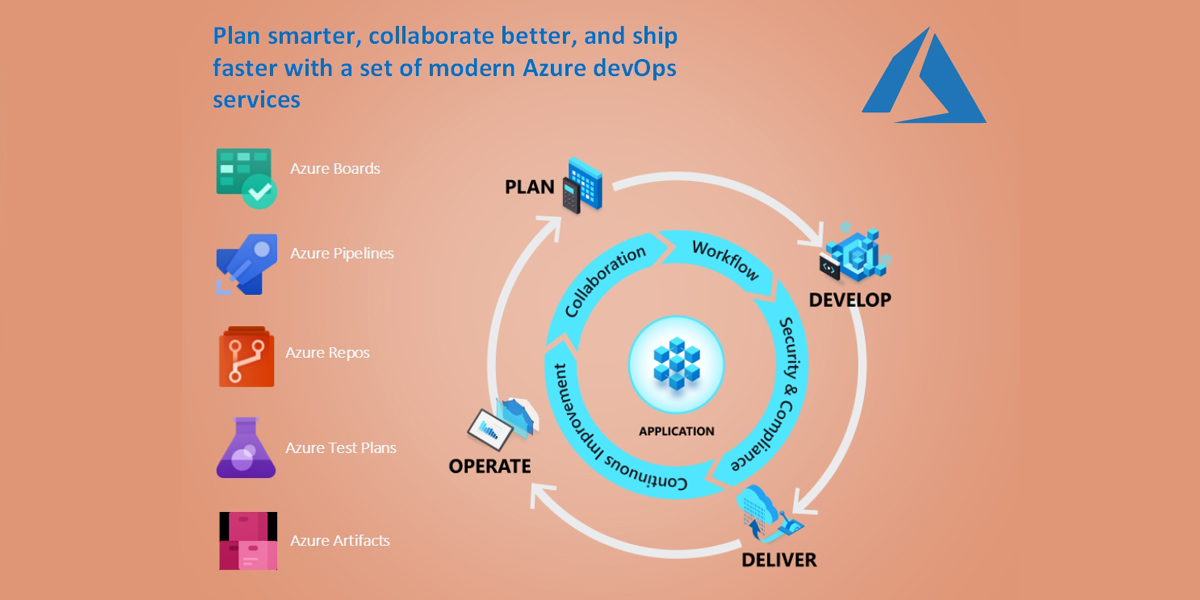DevOps is the union of people, process, and products to enable continuous delivery of value to your end users. DevOps practices that enable transparency, cooperation, continuous delivery and continuous deployment become embedded in your software development lifecycle.
Azure DevOps is a set of services that gives you the tools you need to do just that. With Azure DevOps, you can build, test, and deploy any application, either to the cloud or on premises.
DevOps solution that meets your needs with built-in Azure services such as Azure DevOps. Likewise, put together a combination open-source DevOps tools to match your unique workflow, then seamlessly integrate them on Azure. Whether your app uses virtual machines, web apps, or Kubernetes, implement DevOps practices like continuous integration and continuous delivery (CI/CD), infrastructure as code and continuous monitoring with Azure and the DevOps toolchain of your choice.
CI/CD:
From code to cloud, automate each part of the DevOps process with continuous integration and continuous delivery and your choice of tooling:
- Define a CI/CD pipeline and manage releases with multiple environments using Azure Pipelines.
- Target any service on Azure including Azure Kubernetes Service (AKS), Azure Virtual Machines, or Azure Functions.
- Automate workflows with GitHub Actions.
- Host Jenkins workloads, extend existing configuration, or simplify CI/CD with Jenkins plug-ins for Azure.
Create fast and repeatable deployments into Azure with Spinnaker.
AGILE:
Adopt Agile software development methods with planning, tracking and reporting for shorter release cycles and full visibility into your software development process. Manage projects with GitHub. And, use Azure Boards to:
- Define, assign and track work items.
- Manage backlogs.
- Create custom dashboards to track progress.
- Get advanced analytics and reporting.
VERSION CONTROL:
Manage Git repositories, share and collaborate with GitHub. Create a reliable code workflow for your team with:
- Pull requests and code reviews.
- Issue tracking.
- Continuous integration tools—including apps from the GitHub Marketplace.
INFRASTRUCTURE AS CODE:
Define cloud resources in a descriptive way so that environments are versioned and committed together with application code into repositories. Treating infrastructure as code lets you deploy cloud resources in repeatable and reliable fashion, ensuring cloud environments are fully governed.
- Define repeatable, fully governed environments with Azure Blueprints.
- Use open-source tools such as HashiCorp Terraform and Ansible with full support for Azure resources.
CONFIGURATION MANAGEMENT:
Manage resource configuration across your entire system to enforce desired states, roll out configuration updates and automate resolution of unexpected changes and issues. Azure offers multiple DevOps tools for configuration management including Ansible, Chef, Puppet and Azure Automation.
MONITORING:
Monitor infrastructure health and integrate into existing dashboards in Grafana, Kibana or the Azure portal with Azure Monitor.
- Practice full stack continuous monitoring.
- Configure actionable alerts across Azure services.
- Collect, query and analyze logs to gain insights and mitigate issues.
- Use built in container monitoring for Azure Kubernetes Service (AKS).

